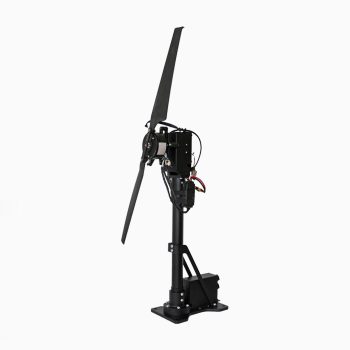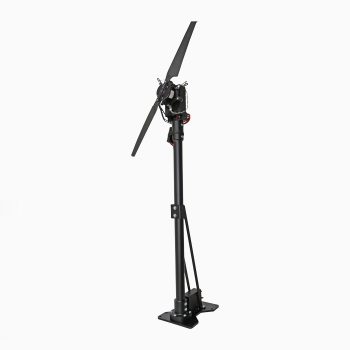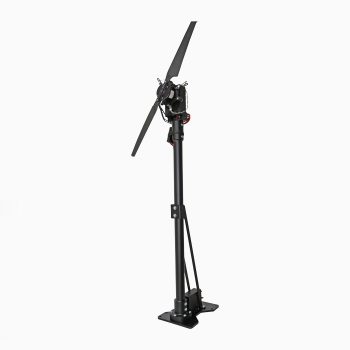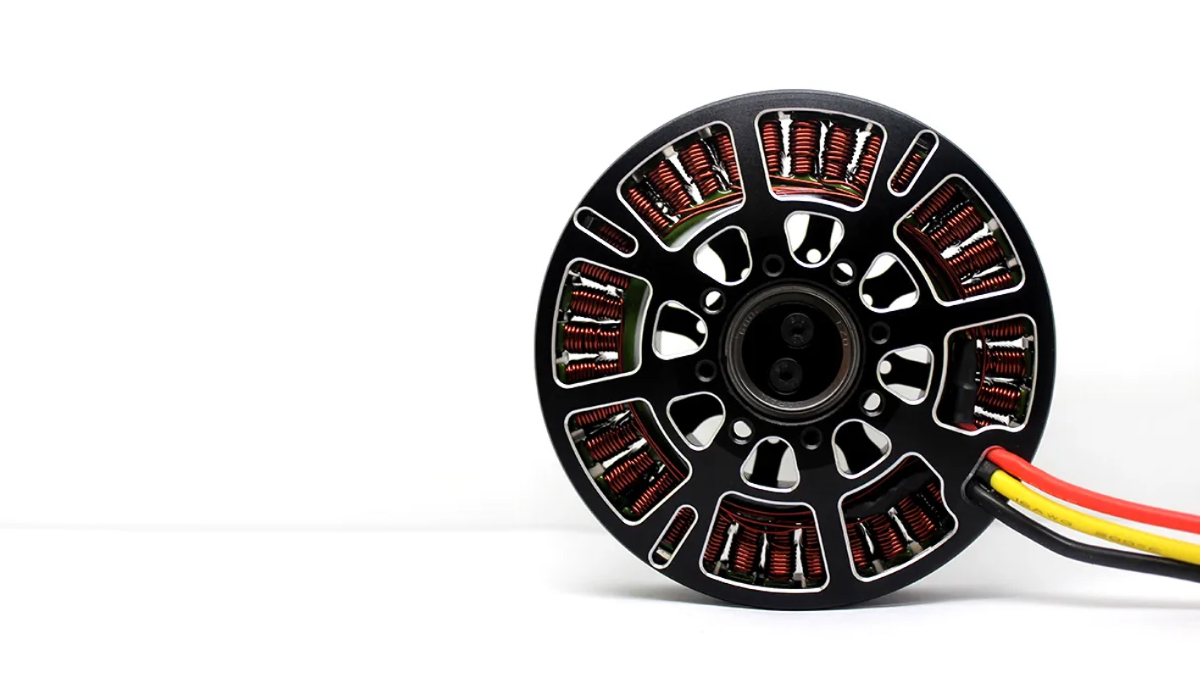Brushless motors play a critical role in the development of electric aircraft, as they are a key component of electric propulsion systems. Here are some key roles of brushless motors in the development of electric aircraft:
- Propulsion: Brushless motors are used as the primary source of propulsion in electric aircraft. They convert electrical energy from the aircraft’s battery into mechanical energy, driving the aircraft’s propellers or fans to generate thrust. Brushless motors are known for their high efficiency and torque-to-weight ratio, making them ideal for electric propulsion systems. They provide the necessary power and performance required for electric aircraft to achieve takeoff, climb, cruise, and landing operations.
- Weight Savings: Brushless motors are generally lighter compared to traditional motors with brushes and commutators, which is crucial for electric aircraft where weight is a critical factor. Electric aircraft require lightweight components to offset the weight of batteries, which are typically heavier than conventional aviation fuels. The lighter weight of brushless motors contributes to increased payload capacity, longer flight endurance, and improved overall performance of electric aircraft.
- Reliability: Brushless motors are known for their high reliability, as they do not have brushes and commutators that can wear out or fail over time. This makes brushless motors well-suited for the demanding and safety-critical aviation environment. The absence of brushes and commutators reduces the risk of motor failures, contributing to improved reliability and safety in electric aircraft operations.
- Integration with Avionics: Brushless motors can be easily integrated with avionics and flight control systems in electric aircraft. They can be controlled and monitored digitally, allowing for precise control of motor speed, torque, and other parameters. Brushless motors can also be integrated with other safety features, such as fault detection and diagnostic systems, to ensure safe and reliable operation of the aircraft. The digital integration of brushless motors with avionics enables advanced functionalities, such as regenerative braking, energy recovery, and optimized power management, which can further enhance the performance and efficiency of electric aircraft.
- Environmental Sustainability: Brushless motors, being a part of electric propulsion systems, contribute to the environmental sustainability of electric aircraft. Electric aircraft produce zero direct emissions, such as carbon dioxide and other pollutants, during operation. Brushless motors, being highly efficient, also help to maximize the energy utilization from the aircraft’s batteries, reducing energy waste and increasing overall energy efficiency. This makes electric aircraft powered by brushless motors more environmentally friendly compared to traditional aircraft powered by internal combustion engines.
Brushless motors play a vital role in the development of electric aircraft by providing propulsion, weight savings, reliability, integration with avionics, and contributing to environmental sustainability. Brushless motors enable the performance, efficiency, and safety of electric aircraft, making them a critical technology in the advancement of aviation towards more sustainable and environmentally friendly solutions.
Understanding the Basics of Brushless Motors in Electric Aircraft
- Brushless motors are a type of electric motor that are commonly used in electric aircraft propulsion systems. They work on the principle of electromagnetic induction and do not have brushes and commutators, which are found in traditional motors with brushes. Here are some key basics of brushless motors in electric aircraft:
- Construction: Brushless motors consist of a stator, which is a stationary part with coils of wire, and a rotor, which is a rotating part with permanent magnets. The stator and rotor are typically housed in a protective casing. The stator coils are energized with electric current, creating a magnetic field that interacts with the permanent magnets on the rotor, causing it to rotate.
- Commutation: Unlike traditional motors with brushes, brushless motors use electronic commutation to switch the electric current to the stator coils at the right time during the motor’s rotation. This is done using sensors that detect the position of the rotor and control the timing and sequence of the current flow to the coils. Electronic commutation allows for precise control of the motor’s speed, torque, and direction of rotation, making brushless motors highly efficient and reliable.
- Efficiency: Brushless motors are known for their high efficiency, as they do not have brushes that can wear out and cause energy losses. The electronic commutation in brushless motors allows for more efficient use of the electric current, resulting in less energy waste and higher overall efficiency. This contributes to longer flight endurance, improved performance, and reduced energy consumption in electric aircraft.
- Weight Savings: Brushless motors are generally lighter compared to traditional motors with brushes and commutators, as they have a simpler construction without the need for brushes and commutators. The lighter weight of brushless motors helps to offset the weight of batteries in electric aircraft, allowing for increased payload capacity, longer flight endurance, and improved overall performance.
- Reliability: Brushless motors are known for their high reliability, as they do not have brushes that can wear out or fail over time. The absence of brushes reduces the risk of motor failures and increases the overall reliability of the motor. This is crucial in the aviation industry where safety and reliability are paramount.
- Integration with Avionics: Brushless motors can be easily integrated with avionics and flight control systems in electric aircraft. They can be controlled and monitored digitally, allowing for precise control of motor speed, torque, and other parameters. This enables advanced functionalities, such as regenerative braking, energy recovery, and optimized power management, which can further enhance the performance and efficiency of electric aircraft.
- Environmental Sustainability: Brushless motors, as part of electric propulsion systems, contribute to the environmental sustainability of electric aircraft. Electric aircraft produce zero direct emissions during operation, contributing to reduced carbon footprint and environmental impact. The high efficiency of brushless motors also helps to maximize the energy utilization from the aircraft’s batteries, reducing energy waste and increasing overall energy efficiency.
Brushless motors are a key technology in the propulsion systems of electric aircraft, providing high efficiency, weight savings, reliability, integration with avionics, and contributing to environmental sustainability. They are widely used in the aviation industry to enable the performance, efficiency, and safety of electric aircraft, and are expected to continue to play a crucial role in the future of aviation as electric aircraft become more prevalent.
The Future of Electric Aircraft: How Brushless Motors Will Play a Key Role
The future of aviation is increasingly focused on electric aircraft, and brushless motors are expected to play a key role in this transformation. Here are some ways how brushless motors will likely be crucial in the future of electric aircraft:
- Enhanced Performance: Brushless motors are known for their high efficiency and precise control, which can significantly enhance the performance of electric aircraft. They can provide higher power-to-weight ratios, allowing for faster acceleration, higher speeds, and improved overall performance. Brushless motors also offer smooth and responsive control, enabling advanced flight maneuvers and optimized power management.
- Longer Flight Endurance: Brushless motors, being highly efficient, can help increase the flight endurance of electric aircraft. With their efficient use of electric power, brushless motors can help extend the range of electric aircraft, allowing for longer flights and increased operational capabilities. This is crucial for electric aircraft, as longer flight endurance is a key factor for their practicality and commercial viability.
- Enhanced Safety: Brushless motors can contribute to improved safety in electric aircraft. Their reliable and durable design, combined with electronic commutation, reduces the risk of motor failures, minimizing the chances of in-flight emergencies. Brushless motors also generate lower heat compared to traditional motors with brushes, which can help with improved thermal management and reduce the risk of overheating and fires.
- Reduced Maintenance Costs: Brushless motors typically have fewer moving parts compared to traditional motors with brushes, resulting in lower maintenance requirements and costs. The absence of brushes and commutators eliminates the need for regular replacement and maintenance, reducing downtime and maintenance expenses. This can result in cost savings in the long run, making electric aircraft more economically viable.
- Environmental Sustainability: Electric aircraft powered by brushless motors are environmentally sustainable, as they produce zero direct emissions during operation. This can contribute to reduced carbon footprint and environmental impact, making electric aircraft a more environmentally-friendly option compared to traditional combustion-powered aircraft. As environmental concerns become more prominent, electric aircraft powered by brushless motors are expected to gain increasing importance in the aviation industry.
- Advances in Technology: Brushless motor technology is continuously evolving, with advancements in materials, design, and electronics. As technology continues to improve, brushless motors are expected to become even more efficient, reliable, and lightweight, further enhancing their performance and safety in electric aircraft. This will likely drive more innovation in electric aircraft design and operations, leading to a brighter future for electric aviation.
Brushless motors are expected to play a crucial role in the future of electric aircraft, contributing to enhanced performance, longer flight endurance, improved safety, reduced maintenance costs, environmental sustainability, and technological advancements. With their many advantages, brushless motors are likely to be a key enabler for the widespread adoption of electric aircraft in the aviation industry, shaping the future of aviation towards more sustainable and efficient transportation.
The Impact of Brushless Motors on the Efficiency and Performance of Electric Aircraft
Brushless motors have a significant impact on the efficiency and performance of electric aircraft. Here are some key ways how brushless motors contribute to the improved efficiency and performance of electric aircraft:
- Higher Efficiency: Brushless motors are known for their high efficiency compared to traditional motors with brushes. They have lower losses due to the absence of brushes and commutators, resulting in less energy wasted as heat and more energy converted into mechanical work. This higher efficiency allows electric aircraft to make better use of the available power, resulting in longer flight endurance, increased range, and improved overall performance.
- Increased Power-to-Weight Ratio: Brushless motors are typically lighter than traditional motors with brushes, resulting in a higher power-to-weight ratio. This means that electric aircraft can have more power with less weight, which can result in improved acceleration, higher speeds, and enhanced overall performance. The higher power-to-weight ratio of brushless motors enables electric aircraft to achieve higher payloads, longer range, and improved operational capabilities.
- Precise Control: Brushless motors offer precise control over the speed and torque, allowing for optimized power management in electric aircraft. This precise control enables advanced flight maneuvers, such as smooth takeoffs and landings, precise hovering, and optimized power distribution during different phases of flight. This can result in improved flight performance, enhanced safety, and increased operational efficiency.
- Smooth and Responsive Operation: Brushless motors offer smooth and responsive operation, allowing for refined control of electric aircraft. They can quickly respond to changing flight conditions and pilot inputs, providing instant power adjustments and precise control over the aircraft’s movements. This smooth and responsive operation can enhance the overall flight experience, improve safety, and optimize flight performance.
- Reduced Vibrations and Noise: Brushless motors produce fewer vibrations and noise compared to traditional motors with brushes. This can result in a smoother and quieter operation of electric aircraft, reducing noise pollution and providing a more comfortable flying experience. Reduced vibrations also help in reducing wear and tear on other aircraft components, resulting in lower maintenance requirements and longer service life.
- Lower Heat Generation: Brushless motors generate lower heat compared to traditional motors with brushes, due to the absence of brushes and commutators. This can help with improved thermal management in electric aircraft, reducing the risk of overheating and increasing overall efficiency. Lower heat generation also contributes to increased reliability and durability of the motor, reducing the risk of motor failures and improving the performance and safety of electric aircraft.
In conclusion, brushless motors have a significant impact on the efficiency and performance of electric aircraft. They offer higher efficiency, increased power-to-weight ratio, precise control, smooth and responsive operation, reduced vibrations and noise, and lower heat generation. These advantages contribute to improved flight endurance, increased range, enhanced operational capabilities, and overall performance of electric aircraft, making brushless motors a crucial component in the development and operation of electric aircraft in the aviation industry.
Overcoming Challenges in the Use of Brushless Motors for Electric Aircraft
While brushless motors offer numerous advantages for electric aircraft, there are also some challenges that need to be overcome to fully utilize their potential. Here are some key challenges in the use of brushless motors for electric aircraft:
- Cost: Brushless motors can be more expensive compared to traditional motors with brushes, which can impact the overall cost of electric aircraft. The initial procurement cost, as well as maintenance and replacement costs, may be higher for brushless motors. However, as technology advances and production volumes increase, the cost of brushless motors is expected to decrease over time.
- Power Density: Brushless motors may have limitations in power density, which refers to the amount of power that can be generated per unit weight or volume. Electric aircraft require high power-to-weight ratios for efficient operation, and achieving high power density with brushless motors can be challenging. Advances in materials, manufacturing techniques, and motor design are being explored to overcome this challenge and improve the power density of brushless motors.
- Thermal Management: Brushless motors can generate heat during operation, and efficient thermal management is crucial for their reliable and safe operation in electric aircraft. Overheating can degrade motor performance, reduce efficiency, and shorten the lifespan of the motor. Effective cooling and thermal management systems are required to dissipate heat and maintain optimal operating temperatures, especially during high-power operations.
- Electromagnetic Interference (EMI): Brushless motors can generate electromagnetic interference (EMI) due to their high switching frequencies and voltage spikes. EMI can interfere with other electronic systems in the aircraft, such as avionics and communication systems, and cause performance issues. Shielding, filtering, and other EMI mitigation techniques need to be implemented to minimize EMI and ensure reliable and safe operation of electric aircraft.
- Regulatory and Safety Considerations: The aviation industry is subject to stringent regulations for safety and certification. The use of brushless motors in electric aircraft may require compliance with specific regulatory standards and certifications, including those related to motor performance, reliability, durability, and safety. Meeting these standards and certifications can pose challenges and may require additional testing, validation, and documentation.
- Infrastructure and Charging: Electric aircraft require adequate infrastructure for charging and power distribution. The availability of charging stations, power grid capacity, and charging protocols are crucial considerations for the operation of electric aircraft. The development of charging infrastructure that can support the unique requirements of electric aircraft, including the high-power charging needs of brushless motors, is an ongoing challenge that needs to be addressed for widespread adoption of electric aircraft.
While brushless motors offer numerous advantages for electric aircraft, there are also challenges that need to be overcome to fully harness their potential. These challenges include cost, power density, thermal management, electromagnetic interference, regulatory and safety considerations, and infrastructure and charging requirements. Continued research, development, and innovation are needed to address these challenges and further advance the use of brushless motors in electric aircraft.





